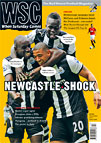 Adam Bushby and Rob MacDonald discuss Manchester City’s proposed new youth facility
Adam Bushby and Rob MacDonald discuss Manchester City’s proposed new youth facility
Manchester City’s application for a new youth academy and training facility, covering 80 acres and set to cost £100 million, will be considered by the city council on December 22. It is perhaps the most audacious of the various methods by which clubs have sought to emulate Barcelona’s La Masia academy. While the latter has evolved – it moved to a new location on June 30 as Masia-Centre de Formació Oriol Tort – and facilities all over the world have been refurbished and updated piecemeal, City are the only club attempting to drop an entire state-of-the-art complex on top of an already successful academy.
As the first team improves annually and UEFA’s Financial Fair Play regulations loom, the development of domestic talent will be an increasingly pressing concern. An ingrained philosophy as seen at Barcelona is currently the benchmark for a club of City’s lofty ambition.
“You tend to levitate toward places and philosophies that have developed young talent and Barcelona, in football, are up there with the best,” said Brian Marwood, the club’s football administration officer. The hope seems to be that a new City team will evolve that shares the innate understanding La Masia has bred among its proteges.
But Barcelona’s famous system was only really born in 1979 and is itself a copy. Johan Cruyff was the driving force behind the re-modelling of the club headquarters to resemble the youth set-up at Ajax, from which he had graduated. By the time Cruyff became Barcelona coach in 1988, the academy’s first product, Guillermo Amor, was ready for his first-team debut. Pep Guardiola and Carles Busquets followed in 1990.
As a wholehearted believer in the system from which he graduated, Guardiola has been quick to reap the rewards from a new generation. As well as not expecting a quick return on their vast investment, City’s owners, the Abu Dhabi Group, should also consider whether the replication of the Barcelona system is even possible without a figurehead’s personal vision.
Establishing a central ideology of some sort has been key to Barcelona’s success, but while tiki-taka might be in vogue now, it might not be in a few years. Football is prone to continual evolution. Rules change and managers develop tactics to combat successful teams. There is no sign of anyone stopping Barcelona’s dominance yet, but the same thing could have been said in 1990 about Arrigo Sacchi’s AC Milan team. As Real Madrid edge closer, Barcelona could feasibly have to sacrifice style for results in future.
City find themselves deciding between two divergent paths. They could imitate a proven formula knowing that results will not be immediate or use the academy as most other Premier League clubs seem to – reward the boys that can kick hard, run a lot and “put themselves about” from a young age, reinforcing English football’s bad habits, but doing it better than everyone else.
The academy’s success depends on how the club define their ideology. They could develop their own David Silva and focus on a specific type of player to play in a team with a set style. Or they could take on kids with all kinds of attributes, from big, bone-headed centre-backs to box-to-box midfielders. The two approaches would produce very different City teams. Barcelona may be City’s favoured benchmark, but replicating La Masia’s success will need more than petrodollars and promise.
From WSC 298 December 2011